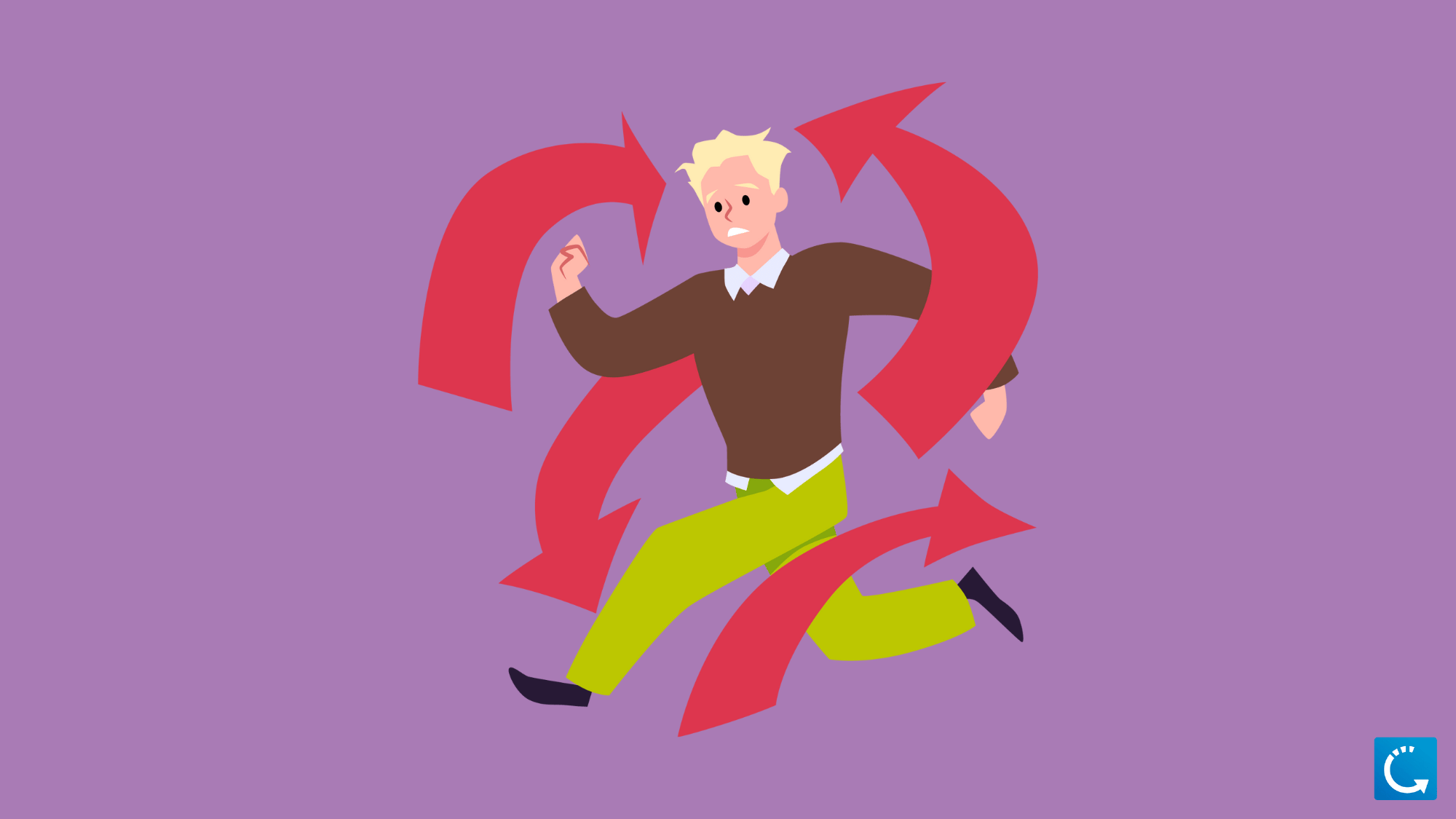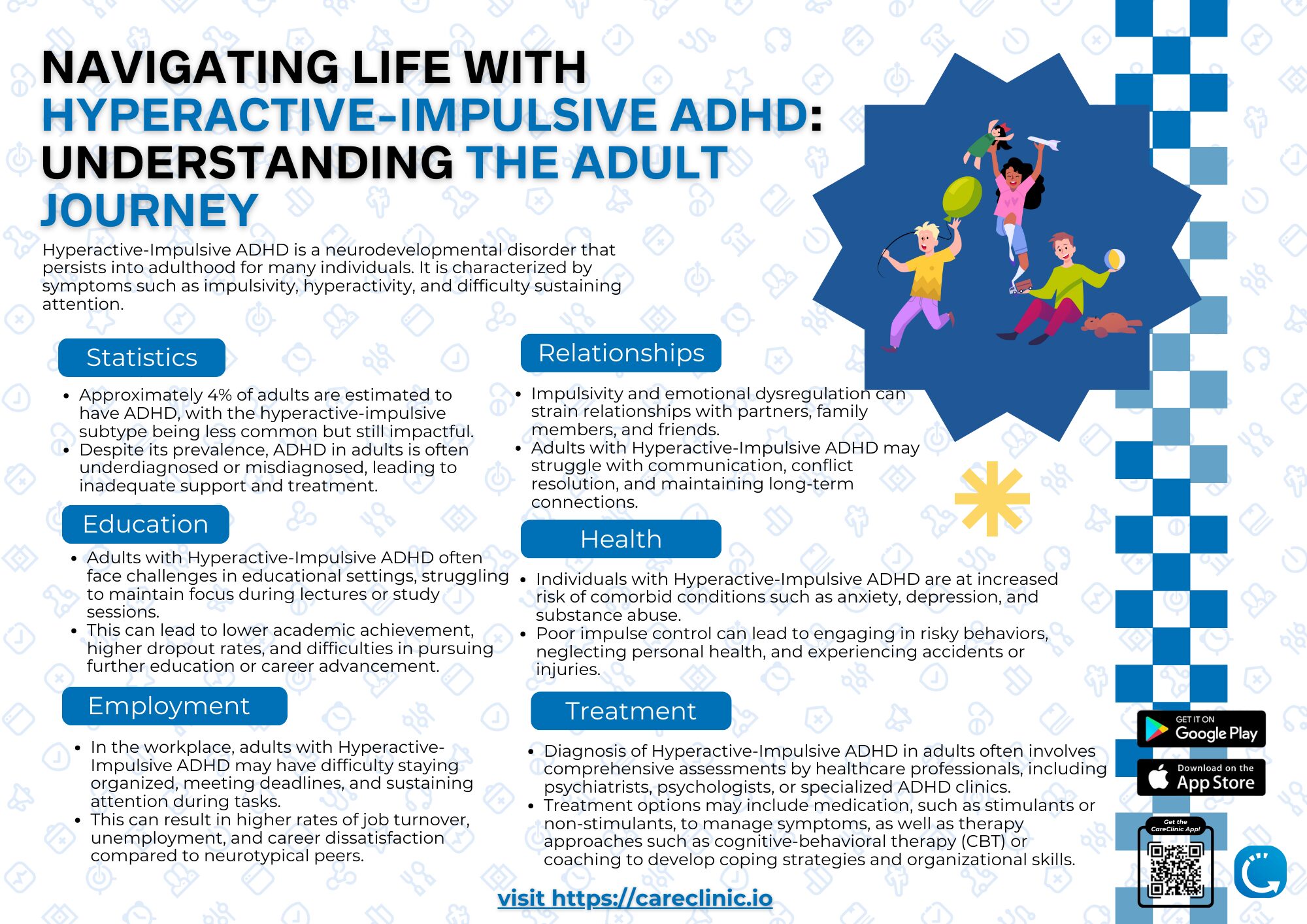
Attention-deficit/hyperactivity disorder (ADHD) is often linked to children, but it can continue into adulthood with different manifestations. This article focuses on hyperactive-impulsive ADHD in adults, exploring its core symptoms, differences from other ADHD types, and available diagnostic and treatment options. By understanding the core symptoms, distinguishing them from other types of ADHD, and exploring treatment options can help individuals effectively manage the condition.
Defining Hyperactive-Impulsive ADHD
Hyperactive-impulsive ADHD is a neurodevelopmental disorder that affects individuals of all ages. It is characterized by symptoms of impulsivity, hyperactivity, and restlessness. People with this type of ADHD often struggle with self-control, are easily distracted, and may have difficulty organizing tasks or following through with goals. They may also feel a constant need for movement and experience frequent bouts of hyperactivity impulsivity too.
When compared to other ADHD types, such as inattentive or combined, hyperactive-impulsive ADHD tends to involve a greater degree of physical restlessness and impulsive behavior. However, it is important to note that symptoms and their severity can vary from person to person.
Living with hyperactive-impulsive ADHD can be challenging. Imagine constantly feeling like you have an internal motor that never stops running. Making it difficult to sit still or stay focused. Simple tasks that others may find easy can become overwhelming obstacles for individuals with this type of ADHD. The constant need for movement can be frustrating, and the impulsive behavior can lead to regrettable actions.
The Core Symptoms of Attention Deficit Hyperactivity Disorder
The core symptoms of hyperactive-impulsive ADHD primarily revolve around impulsivity and hyperactivity. Some common signs include:
- Blurting out answers or interrupting others during conversations or activities
- Fidgeting or squirming in one’s seat
- Feeling unable to stay seated for prolonged periods
- Engaging in excessive talking or being overly talkative
- Acting on impulsive desires or urges without considering potential consequences
These symptoms, when present and persistent, can significantly impact an individual’s personal and professional life. Leading to difficulties in relationships and daily functioning. It is not uncommon for individuals with hyperactive-impulsive ADHD to face challenges in school or work environmental factors. As their restlessness and impulsivity can make it hard to concentrate or complete tasks.
The Difference Between Hyperactive-Impulsive ADHD and Other Types
Hyperactive-impulsive ADHD differs from other ADHD types in terms of the predominant symptoms exhibited. Inattentive ADHD, for example, is characterized by the difficulty paying attention, focusing, forgetfulness, and disorganization, whereas the combined type includes a combination of both inattentive and hyperactive-impulsive symptoms.
Understanding the specific type of ADHD an individual has is crucial in determining the most appropriate treatment options and strategies for managing symptoms effectively. It is important to remember that ADHD is a complex disorder that affects individuals differently, and a comprehensive evaluation by a healthcare professional is necessary for an accurate diagnosis.
Living with hyperactive-impulsive ADHD can be a journey filled with ups and downs. However, with the right support, understanding, and management strategies, individuals with this type of ADHD can thrive and reach their full potential.
The Impact of Hyperactive-Impulsive ADHD in Adult Life
In adulthood, hyperactive-impulsive ADHD can present unique challenges. Two areas often significantly affected by bipolar disorder are personal relationships and the workplace environment.
ADHD and Personal Relationships
Individuals with hyperactive-impulsive ADHD may struggle with maintaining close and fulfilling relationships. The impulsivity and restlessness associated with this condition might lead to impulsive decision-making and difficulty listening and responding attentively to others. This can strain relationships and hinder effective communication.
For example, in social situations, individuals with hyperactive-impulsive ADHD may find it challenging to control their impulses, leading to more impulsive behaviors, outbursts or interrupting others while they are speaking. This can create tension and misunderstanding, making it harder to build and maintain meaningful connections.
To combat these challenges, it is essential for individuals to seek support and understanding from their loved ones. Strategies such as practicing active listening, using organizational tools like the CareClinic App to manage tasks and appointments, and engaging in regular self-reflection can help improve relationship dynamics.
Furthermore, therapy and counseling can provide individuals with the necessary skills and coping mechanisms to navigate the complexities of personal relationships. By learning effective communication techniques and impulse control strategies, individuals can foster healthier and more fulfilling connections with their loved ones.
Navigating ADHD Symptoms in the Workplace
Hyperactive-impulsive ADHD can also impact an individual’s professional life. Difficulties with focus, impulsivity, and restlessness may lead to trouble meeting deadlines, staying organized, and maintaining attention during tasks. This can result in decreased productivity and potential conflict with coworkers or supervisors.
Moreover, individuals with hyperactive-impulsive ADHD may find it challenging to prioritize tasks and manage their time effectively. This can lead to a constant sense of being overwhelmed and struggling to keep up with the demands of the workplace.
Strategies for Success
Managing ADHD symptoms in the workplace requires a combination of self-care strategies and accommodations. Developing a routine, breaking down tasks into manageable steps, and utilizing organizational tools such as the CareClinic App can help individuals stay on track.
Individuals with hyperactive-impulsive ADHD should advocate for workplace accommodations such as flexible hours, modified tasks, or quiet workspaces. Collaborating with employers and colleagues can help create a supportive environment and maximize success.
Hyperactive-Impulsive Type ADHD Diagnosis in Adults
Receiving an accurate diagnosis is essential for individuals to access appropriate treatment and support. Diagnosis typically involves a comprehensive evaluation that considers the individual’s medical history, symptom presentation, and the exclusion of other potential causes of their symptoms.
Adults seeking a diagnosis for hyperactive-impulsive ADHD may find the process both challenging and enlightening. It typically starts with a visit to a mental health professional, such as a psychiatrist or psychologist, who can assess and identify ADHD symptoms in adults. These specialists are skilled in recognizing the complexities of adult ADHD and can provide a comprehensive evaluation.
1. Common Diagnostic Criteria for ADHD Treatment: Diagnostic criteria for hyperactive-impulsive ADHD include the presence of symptoms such as impulsivity, hyperactivity, and restlessness that persist for more than six months and significantly interfere with daily functioning. The evaluation often involves interviews, questionnaires, and assessments conducted by qualified healthcare professionals.
2. Inattentive ADHD and Overlapping Conditions: Misdiagnosis and overlapping conditions can complicate the diagnostic process. Conditions such mental disorders as anxiety disorders, mood disorders or mood swings, and learning disabilities may share symptoms with hyperactive-impulsive ADHD. It is crucial for healthcare professionals to consider these possibilities and conduct a thorough evaluation to ensure an accurate diagnosis.
For many adults, co-existing conditions like depression or substance abuse can complicate ADHD diagnosis by masking or worsening symptoms. It’s crucial for healthcare providers to unravel these complex interactions for an accurate diagnosis.
Treatment Options for Hyperactive-Impulsive ADHD
While there is no cure for hyperactive-impulsive ADHD, there are various treatment options available to manage symptoms effectively. It is important to note that treatment plans should be tailored to suit individual needs and may involve a combination of approaches.
Medication: Regulating Symptoms
One of the most common treatment options for hyperactive-impulsive ADHD is medication. These medications work by increasing attention and reducing impulsivity and hyperactivity. It is important to work closely with a healthcare professional to determine the most appropriate medication and dosage for each individual.
Therapeutic Approaches: Developing Coping Strategies
Cognitive-behavioral therapy (CBT) is a commonly used therapeutic approach that helps individuals develop coping strategies, improve time management and organizational skills, and address any co-occurring mental health concerns. Psychoeducation, which involves educating individuals and their families about ADHD and its management, can also be beneficial.
Lifestyle Changes and Coping Strategies: Enhancing Well-being
Adopting lifestyle changes and effective coping strategies can greatly influence the management of hyperactive-impulsive ADHD symptoms. Establishing a consistent routine and breaking tasks into smaller, more manageable steps can enhance focus and organization. Regular exercise and physical activity can also help alleviate restlessness and support overall well-being.
Utilizing Tools for Management: Enhancing Self-care
Utilizing tools and apps like the CareClinic App can be helpful in managing hyperactive-impulsive ADHD. These tools allow individuals to track their symptoms, medication schedules, and appointments, enhancing self-care and management efforts. By staying organized and keeping track of important information, individuals can better manage their condition.
Importance of Self-care: Maintaining Well-being
Remember, self-care is crucial for individuals with hyperactive-impulsive ADHD. Taking breaks, practicing stress-management techniques, and ensuring adequate sleep can go a long way in maintaining overall mental and emotional well-being. It is important to work closely with healthcare professionals to develop a comprehensive treatment plan that addresses individual needs and promotes a balanced and fulfilling life.
The Importance of Support Networks
Building a robust support network is vital for individuals with hyperactive-impulsive ADHD. This network can consist of healthcare professionals, family, friends, and other individuals with a similar lived experience.
Having a strong support system is like having a safety net that can catch you when you feel overwhelmed or struggling to cope with the challenges of hyperactive-impulsive ADHD. It provides a sense of security and comfort knowing that there are people who understand your journey and are there to offer guidance and encouragement.
Finding Professional Help
Seeking professional help from qualified healthcare providers, such as doctors and therapists experienced in ADHD, is crucial for developing a comprehensive treatment plan. These professionals can provide guidance, support, and individualized recommendations.
Professional help goes beyond just receiving a diagnosis or medication; it involves building a collaborative relationship with experts who can help you navigate the complexities of managing hyperactive-impulsive ADHD. They can assist in developing coping strategies, setting realistic goals, and monitoring progress to ensure holistic care.
Building a Personal Support System
In addition to professional help, building a personal support system can offer understanding, empathy, and reassurance. Connecting with support groups, engaging in online forums, or participating in group therapy can help individuals with hyperactive-impulsive ADHD develop meaningful connections and learn from others’ experiences.
Sharing your experiences and listening to others in similar situations can foster a sense of belonging and reduce feelings of isolation often associated with ADHD. It creates a space where individuals can exchange tips, celebrate victories, and provide comfort during setbacks, fostering a sense of community and mutual empowerment.
By understanding hyperactive-impulsive ADHD in adults, individuals can gain insight into their adult ADHD symptoms, seek appropriate diagnosis and treatment, and equip themselves with effective self-care strategies. Remember, managing ADHD does not have to be done alone.
Utilizing CareClinic for Hyperactive Impulsive ADHD
Manage ADHD effectively with the CareClinic App. Track activities, medication, and mood to gain insights into patterns and triggers, helping you make informed health decisions.
With features like medication reminders and a symptom tracker, the CareClinic App helps ensure consistency and accuracy in managing your condition. Embrace a proactive approach to your diagnose ADHD management and experience the benefits of personalized health tracking.
Download the CareClinic App to Manage ADHD Symptoms
Ready to transform the way you manage hyperactive-impulsive ADHD? Install the CareClinic App today and join a community of users who are achieving improved health outcomes. The app’s user-friendly interface helps you easily track progress and adjust treatment, empowering your wellness journey. Don’t navigate treating ADHD alone; let the CareClinic App be your partner in achieving a more focused and organized life.



